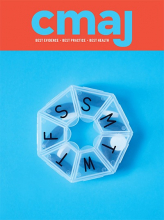A 65-year-old woman with hypertension, diabetes mellitus and chronic kidney disease presented to the emergency department with dysuria and lower abdominal pain of 1 day. The patient’s body temperature was 36.9°C, heart rate 105 beats/min and blood pressure 191/84 mm Hg.
Her physical examination was unremarkable except for local tenderness over the right lower quadrant of the abdomen. Results from laboratory analyses showed that the patient had leukocytosis (white blood cell count 15.2 [normal range 4.5–11.0] × 109/L), hyperglycemia (glucose level 21 [normal range 3.3–5.6] mmol/L), and elevated concentrations of C-reactive protein (6352 [normal < 200] nmol/L), lactate (3.0 [normal range 0.5–2.2] mmol/L), procalcitonin (19.59 [normal < 0.05] ng/mL) and creatinine (534 [normal range 50–90] μmol/L). Radiography of the abdomen (Figure 1) showed circular gas within the bladder wall. Point-of-care ultrasonography showed a hyperechoic interface with reverberation artifacts around the bladder (Appendix 1, Supplementary Figure 1A, available at www.cmaj.ca/lookup/suppl/doi:10.1503/cmaj.191288/-/DC1). Computed tomography (CT) of the abdomen showed the bladder wall contoured by mottled air bubbles. We diagnosed emphysematous cystitis (Appendix 1, Supplementary Figure 1B). The patient’s bladder was drained, and we administered broad-spectrum antibiotics. Klebsiella pneumoniae was isolated from a urine culture. Results from 2 sets of blood cultures were negative. The patient was discharged uneventfully 10 days later.
Radiograph of the abdomen of a 65-year-old woman with emphysematous cystitis showing circular air in the bladder wall.
Emphysematous cystitis is an uncommon type of severe necrotizing infection of the urinary bladder. It is potentially life threatening and requires prompt diagnosis and treatment. Risk factors include having diabetes, being female, or a history of neurogenic bladder, obstructive uropathy and possibly immunosuppression. 1,2 Our patient was female and had diabetes.
Clinical presentations of emphysematous cystitis vary from no symptoms, abdominal pain, pneumaturia, ischuria and gross hematuria to severe sepsis.1 Computed tomography is the best modality for early diagnosis. Escherichia coli, K. pneumoniae and Enterobacter spp. are the most common bacteria isolated from urinary cultures.2 Most cases of emphysematous cystitis can be treated successfully with antibiotics, bladder drainage and correction of the underlying disorder. A review of 135 reported cases found a 10% surgical intervention rate, typically for necrotizing infection or failure of conservative therapy, and a 7% mortality rate, but these figures may overestimate the current rates.3
Footnotes
Competing interests: None declared.
This article has been peer reviewed.
The authors have obtained patient consent.









